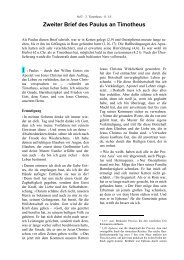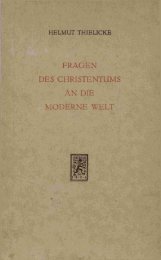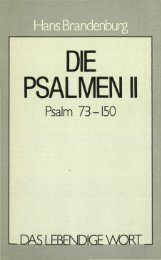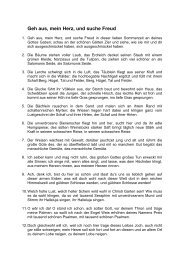You also want an ePaper? Increase the reach of your titles
YUMPU automatically turns print PDFs into web optimized ePapers that Google loves.
The blood<br />
– a universal transport<br />
medium<br />
The blood (Latin sanguis, Greek haima) is the<br />
great transport medium of the body. While circulating,<br />
this liquid 1 performs several important<br />
functions:<br />
1 Respiration: The blood carries oxygen from the<br />
lungs to all body tissues for them to utilise. At<br />
the same time carbon dioxide is carried from the<br />
tissues back to the lungs where it is exhaled. This<br />
vital function is mainly performed by the red<br />
blood cells.<br />
2 Nourishment: The cells of the body continually<br />
require energy and raw materials, and the blood<br />
plays an all-important part by transporting nutrients<br />
to the individual cells of the body. The products<br />
resulting from the digestion of food are<br />
absorbed by the blood from the gut (mainly the<br />
small intestine). The length of the small intestine<br />
is between five and seven metres, and its total<br />
surface area exceeds that of the lungs. If one<br />
were to iron out all its protuberances, its area<br />
would be larger than a tennis court. Nutrients,<br />
dissolved in water, are collected by the blood<br />
from the small intestine and carried to the liver<br />
along the portal vein (vena portae). Consisting of<br />
a patchwork of about 100,000 hexagonal pieces<br />
called lobules (hepatic lobule, Greek hepar =<br />
1 Measures of volume: Many types of volume are<br />
mentioned in this chapter, and the following conversion<br />
table may be useful in this respect:<br />
1 cubic metre = 1 m 3 = 1000 dm 3 = 1000 l<br />
1 cubic decimetre = 1 dm 3 = 1 litre<br />
1 cubic centimetre = 1 cm 3 = 1000 mm 3 = 1 millilitre<br />
1 cubic millimetre = 1 mm 3 = 10 9 µm 3<br />
1 cubic micrometre = 1 µm 3 = 1 thousand millionth<br />
of a mm 3<br />
1 litre = 1 l = 1 dm 3 = 1000 cm 3 = 1000 ml = 100 cl<br />
1 centilitre = 1 cl = 10 ml<br />
1 millilitre = 1 ml = 1 cm 3 = 1000 µl<br />
1 microlitre = 1 µl = 1 mm 3<br />
liver), the liver is the largest internal organ. The<br />
basic metabolism of the body takes place in the<br />
liver. Employing unique and wonderful processes,<br />
the cells of the lobules chemically convert sugar,<br />
fats, proteins, and other nutrients. The products<br />
are either stored, re-used, or released. About<br />
30 per cent of the blood leaving the heart passes<br />
through the liver, and from there the nutrients<br />
are distributed throughout the body.<br />
The blood plays another important role in nutrition:<br />
Superfluous nutrients are stored in certain<br />
“depots” and transported to active cells when<br />
required.<br />
3 Excretory function: The end products of cellular<br />
metabolism diffuse into the interstitial spaces<br />
between the cells and from there to the blood.<br />
These chemicals are then filtered out by the<br />
excretory <strong>organs</strong>, mainly the kidneys. (Excretion =<br />
the removal or elimination of metabolic products<br />
(excreta) which cannot be used by the body, like<br />
urine and sweat; in contrast, the process of secretion<br />
produces substances which the body needs.)<br />
4 The control of concentrations: The cells of the<br />
body can only function optimally when the prevailing<br />
internal conditions are within certain limits<br />
(eg. the concentration of dissolved substances<br />
should be constant, as well as the temperature<br />
and the acid-base ratio). Certain <strong>organs</strong> continually<br />
monitor these blood values and correct them<br />
when necessary. The composition of the intercellular<br />
liquids is kept in equilibrium by interchanges<br />
with the blood.<br />
5 Temperature control: At the normal temperature<br />
of the body, 37 °C, all processes function<br />
optimally. The <strong>organs</strong> generate heat, but the<br />
main component of the blood, water, has a high<br />
specific heat value, so that the heat capacity of<br />
blood is also high. Furthermore, since the blood<br />
flows continually, the transfer of heat is much<br />
faster than in the case of a non-moving liquid.<br />
On the one hand, the blood absorbs any excess<br />
heat, which is then dissipated over the surface<br />
of the body and through the lungs. On the other<br />
hand, circulation of the blood ensures that all<br />
parts of the body receive the necessary heat.<br />
57
















